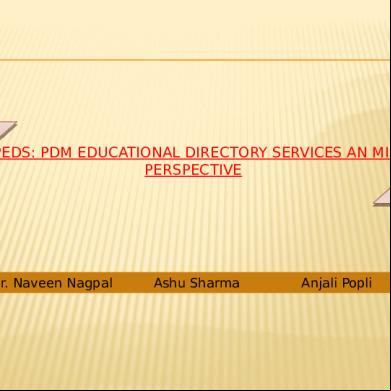Mis Ppt (ashu And Anjali) 631vr
This document was ed by and they confirmed that they have the permission to share it. If you are author or own the copyright of this book, please report to us by using this report form. Report 3b7i
Overview 3e4r5l
& View Mis Ppt (ashu And Anjali) as PDF for free.
More details w3441
- Words: 700
- Pages: 14
PEDS: PDM EDUCATIONAL DIRECTORY SERVICES AN MIS PERSPECTIVE
Mr. Naveen Nagpal
Ashu Sharma
Anjali Popli
INTRODUCTION TO MIS Management Information System(MIS) provides information for the managerial activities in an organization. The main purpose of this research is, MIS provides accurate and timely information necessary to facilitate the decision-making process and enable the organization planning, control, and operational functions to ne carried out effectively. Management information system(MIS) is basically concerned with processing data into information and is then communicated to the various Departments in a organization for appropriate decision- making.
WHAT IS MIS? Right
Information To the right person At the right place At the right time In the right form At the right cost
PEDS: PDM EDUCATIONAL DIRECTORY SERVICES The PEDS basically stands for PDM EDUCATIONAL DIRECTORY SERVICES is one MIS tool to control and monitor the educational system. From the student viewpoints they get the required notes, assignments, past papers and syllabus in advance from the commencement of the semester. From the faculty point of view they get the platform upon they put up their notes, syllabus, past papers, assignment and weekly reports. Through this tool the Management gets a comprehensive view of the quality and quantitative analysis education imparted upon the student and time management of the staff.
EFFECTIVENESS OF PEDS It
provides a platform for the student, faculty and core management to come on the same platform. It enriches the students with the current syllabus, past papers, assignments, time tables and notes unit wise semester wise. Each ed student is given and . In the early stages of its development, PDMREA IT division faced challenges related to the implementation of the PEDS, Among the “teething” problems were: a) lack of data integration and quantitative analysis skills. b) lack of system and program monitoring and evaluation. c) lack of policy research and analysis. d) lack of optimal way to allocate resources e) decision made that lack data evidence.
To use the PEDS the student can into the IE(Integrated Environment)
After successful the can go to Dashboard, Course Ware, Time Table or Sign Out.
From
the dash board the faculty member can view their allocated subjects, the notes, syllabus and assignment which can be ed at anywhere. This provide an opportunity for the stake holder(the student and the management ) to view and it any where. Moreover it provide an plank to write the comments on the various events organized in the campus. It also provide feature of viewing profile of any student or any faculty member that logged into PEDS.
From this the faculty can view what is latest assignment loaded, currently assigned subjects or even reset . The student can get the latest knowledge about the semester exam, campus notices and practical exams at his end. From the management point of view the management can view what are the subjects being allocated to each faculty, ed notes and assignments. Moreover by weekly report the management can judge the effective load on each faculty and can take effective decision.
FEATURES OF PEDS PDM Educational Directory Services (PEDS) provides world-class web services to students, faculty and istrative staff. This is where you can access Time-Table, Notes, Assignments, Subjects, Syllabus, Past Papers and Assigned Subjects etc. PEDS also offers other services: a) Report lost/stolen id card or ipad. b) Send your valuable . c) Write your own blog.
CONCLUSION: The development of MIS in any institution of higher learning is important for a modern management of the education system. Computer applications, technology and the data base assist in data and information gathering, use and dissemination. The development of MIS is not limited to creating a data and information system but more importantly, the development of a new management culture of information sharing. As seen from the case study of PDM, policy decisions are related to business profits for the organization. As a parting comment, the organization’s investment in MIS must be coupled with the clear sense of a education strategy.
THANK YOU FOR YOUR ACTIVE LISTENING
Mr. Naveen Nagpal
Ashu Sharma
Anjali Popli
INTRODUCTION TO MIS Management Information System(MIS) provides information for the managerial activities in an organization. The main purpose of this research is, MIS provides accurate and timely information necessary to facilitate the decision-making process and enable the organization planning, control, and operational functions to ne carried out effectively. Management information system(MIS) is basically concerned with processing data into information and is then communicated to the various Departments in a organization for appropriate decision- making.
WHAT IS MIS? Right
Information To the right person At the right place At the right time In the right form At the right cost
PEDS: PDM EDUCATIONAL DIRECTORY SERVICES The PEDS basically stands for PDM EDUCATIONAL DIRECTORY SERVICES is one MIS tool to control and monitor the educational system. From the student viewpoints they get the required notes, assignments, past papers and syllabus in advance from the commencement of the semester. From the faculty point of view they get the platform upon they put up their notes, syllabus, past papers, assignment and weekly reports. Through this tool the Management gets a comprehensive view of the quality and quantitative analysis education imparted upon the student and time management of the staff.
EFFECTIVENESS OF PEDS It
provides a platform for the student, faculty and core management to come on the same platform. It enriches the students with the current syllabus, past papers, assignments, time tables and notes unit wise semester wise. Each ed student is given and . In the early stages of its development, PDMREA IT division faced challenges related to the implementation of the PEDS, Among the “teething” problems were: a) lack of data integration and quantitative analysis skills. b) lack of system and program monitoring and evaluation. c) lack of policy research and analysis. d) lack of optimal way to allocate resources e) decision made that lack data evidence.
To use the PEDS the student can into the IE(Integrated Environment)
After successful the can go to Dashboard, Course Ware, Time Table or Sign Out.
From
the dash board the faculty member can view their allocated subjects, the notes, syllabus and assignment which can be ed at anywhere. This provide an opportunity for the stake holder(the student and the management ) to view and it any where. Moreover it provide an plank to write the comments on the various events organized in the campus. It also provide feature of viewing profile of any student or any faculty member that logged into PEDS.
From this the faculty can view what is latest assignment loaded, currently assigned subjects or even reset . The student can get the latest knowledge about the semester exam, campus notices and practical exams at his end. From the management point of view the management can view what are the subjects being allocated to each faculty, ed notes and assignments. Moreover by weekly report the management can judge the effective load on each faculty and can take effective decision.
FEATURES OF PEDS PDM Educational Directory Services (PEDS) provides world-class web services to students, faculty and istrative staff. This is where you can access Time-Table, Notes, Assignments, Subjects, Syllabus, Past Papers and Assigned Subjects etc. PEDS also offers other services: a) Report lost/stolen id card or ipad. b) Send your valuable . c) Write your own blog.
CONCLUSION: The development of MIS in any institution of higher learning is important for a modern management of the education system. Computer applications, technology and the data base assist in data and information gathering, use and dissemination. The development of MIS is not limited to creating a data and information system but more importantly, the development of a new management culture of information sharing. As seen from the case study of PDM, policy decisions are related to business profits for the organization. As a parting comment, the organization’s investment in MIS must be coupled with the clear sense of a education strategy.
THANK YOU FOR YOUR ACTIVE LISTENING










